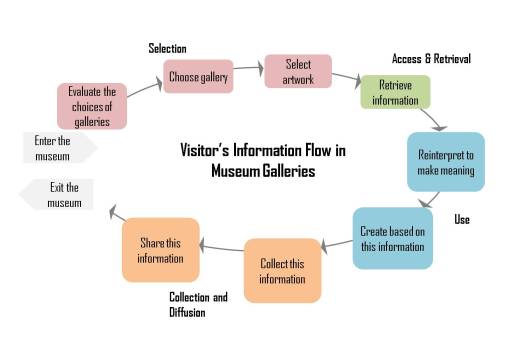I recently came to the revelation that while I might consider myself an Information professional, the concept of information is not something that I have considering fully. What is information? How do my clients, museum-goers, use the information that museums offer?
Upon entering the museum, visitors are faced with numerous choices.
Selection
Evaluate the choices of galleries
• What goes into visitor’s choices? For some, it is interest. They go up to the information desk, asking to find Impressionism. For others, browsers for example, this evaluation phase might be so infinitesimal. It might just be the thoughts, “Turn left? Okay.”
• Often the map plays into this. Some institutions offer visualizations on their maps: picture of key artworks for example. Others give very descriptive gallery titles: American Landscape Painting after 1860. Visitors might go into a gallery based on some interpretation on a map.
• Visitors that take a tour might turn this element over to the museum docent/staff.
Choose Gallery (ies)
• What goes into visitor’s choices? For some, it is interest. Those are the people who had gone up to the information desk, asking to find Impressionism. For the browsers, again this choice might be done visually. They stop at places that look interesting.
• Visitors that take a tour might turn this element over to the museum docent/staff. Though once led there by a docent, if uninterested, a visitor my peel off of the tour.
Select Artwork(s)
• This is an act of judging a book by its cover. Art is often all about cover, or in this case surface. People are often attracted to what they see. They walk up to it to see it better, or to read the label.
• Pre-knowledge plays a part in choosing an artwork. A visitor might go up to a Picasso based on the fact that it “looks” like a Picasso.
• Visitors that take a tour might turn this element over to the museum docent/staff. Though once led there by a docent, if uninterested, a visitor my peel off of the tour.
Access and Retrieval
Retrieve information
• Once they get to the gallery, many people start by reading the label, even before they look at the artwork.
• The other artworks or objects in the space can add context. If the room is filled with paintings of landscapes, you might start to focus on the differences or similarities.
• Information retrieval can involve human intercessors. Docents and staff can share information in front of an artwork. Conversations with friends or even with strangers can be a means of gaining information. Audio guides involved a human voice, but have a digital delivery.
• Museum staff can add content to the space, such as panels that offer context. There could be magnifying glasses or samples of materials.
• But, in this digital era, there are also other means of accessing information. There could be in gallery digital devices. Museum apps can share content. And, of course, there is always Wikipedia, accessible from any smart phone.
Use
Reinterpret to Make Meaning
• In a formal tour, visitors might be prompted by the staff or docents to do this in a collaborative, discussion based manner.
• In reading the label, visitors would likely try to make sense what they read. “So, if it was made in 1917, what was happening at that time,” for example.
• Some interactives (both technological and analog) might invite reinterpretation. Visitors might be asked to include tags or content about art.
Create Based on This Information
• In a class, visitors might be invited to draw.
• But, there are other forms of creation. Visitors might take a selfie with a work. Visitors might tweet about it. (These would also be forms of sharing.)
Collection and Diffusion
Collect this Information
• Visitors might jot down the name of the work on the map.
• They might collect it in the phone camera roll.
• They might just remember the work of art, keeping it in their memory.
Share This Information
• Sharing can be word of mouth. Passing on their reinterpretation to others. This could be in virtual or non-virtual conversations. This could be text or images or a combination of the two.
